All Photos by Alessandro Gerelli at the 2008 Mille Miglia
Text by Pete Vack
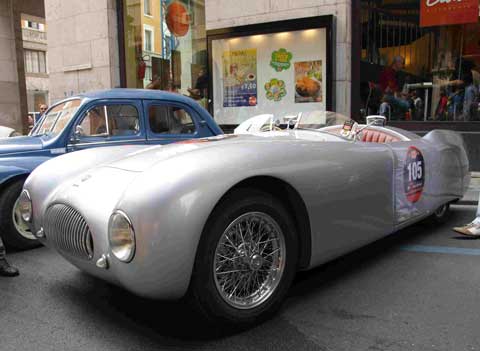
1949 Cisitalia 202 MM, the model Nuvolari drove to second place in the 1947 Mille Miglia. Body was designed by Giovanni Savonuzzi.
The Italians would also dominate the post-war round of Mille Miglia races, but it would no longer be just Alfa Romeo.
Lancia would return to serious competition with the 3.3 liter, Maserati would provide a threat to overall victory, while the new upstart Ferrari would dominate the post-war era much as did Alfa Romeo did the pre-war era.
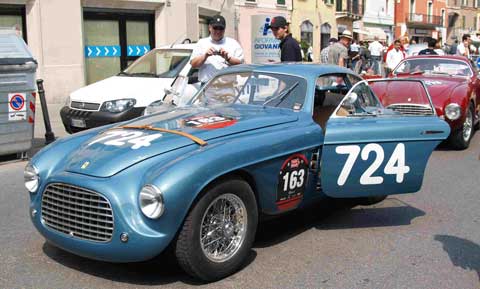 1949 Ferrari 166 MM Touring. Ferrari would win eight of the ten post-war Mille Miglias; Giannino Marzotto would win the 1950 event in a 195S Touring coupe.
1949 Ferrari 166 MM Touring. Ferrari would win eight of the ten post-war Mille Miglias; Giannino Marzotto would win the 1950 event in a 195S Touring coupe.
Significantly, Mercedes Benz again won the 1955 event after narrowly losing to the Ferrari of Giovanni Bracco in 1952, meaning that if foreign competitors really wanted to win the fabled and by-now Italian-only show, they could.
Jaguar and Aston Martin both tried with varying degrees of success, but neither firm treated the Italian road race as seriously as they approached the TT or Le Mans, or even Sebring. The French concentrated on the smaller classes and did well, outshining many small Italian constructors with their unique engineering and reliability.
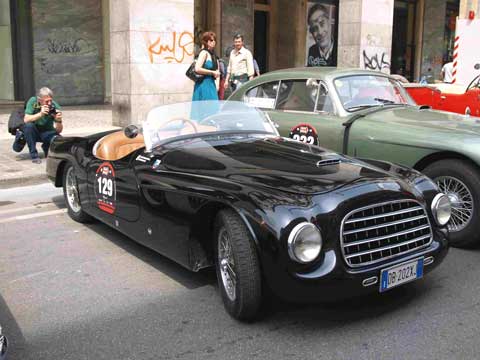
1949 Cisitalia 202 SC spider with a dramatic body by Castagna.
Like the little known O.M. of the interwar years, the post war years had its unknown hero as well. In an era dominated by the force of Ferrari, the tiny firm of Cisitalia made the Mille Miglia its home game territory, and very nearly won the event overall in 1947. Piero Dusio’s firm had everything going for it; Fiat’s great designer, Dante Giacosa, Giovanni Savonuzzi, who sketched the competition bodies, and Tazio Nuvolari, who would be on the team for the first post war race, and finally, he had the attention and services of Battista Pininfarina, who would create his landmark coupe on a Cisitalia chassis. Only Ferrari had it more together.
It was one of the greatest what-ifs ever. What if Nuvolari had actually won that year, what if Dusio had not broke the bank on the Porsche designed F1 car, what if the enchanting and almost too sophisticated Porsche project had succeeded. It all went bad of course, but not for lack of talent, desire, and excellent engineering. And when Cisitalia was on a roll, it was a big roll that shook the automotive world from Modena to Michigan.
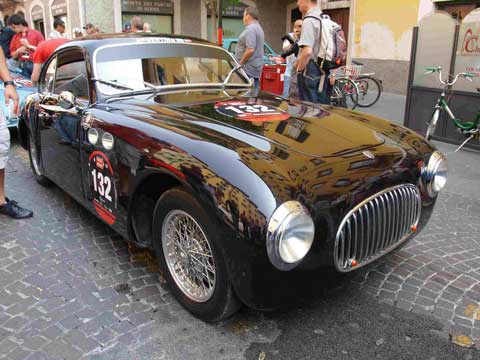
1950 Cisitalia 202 SC. Several of these attractive coupes were entered in the 1950 Mille Miglia.
Nuvolari’s drive in the 1947 race was epic. Although Clemente Biondetti in a closed 8C2300 Alfa won the race, Nuvolari’s 1100cc Cisitalia was either never far behind or actually ahead of the big Alfa. Towards the end of the race, hurricane-like storms hampered the race of the tiny open cockpit Cisitalia, and Nuvolari began to lose time. After 16 hours of racing, Nuvolari finished only 16 minutes behind the Alfa, but was the moral victor. Things like this don’t happen often in today’s world of racing.
Cisis also placed third and fourth in the first postwar event. In 1949 Scagliarini in a Cisitalia placed fifth and did so again in 1950. Off the top ten list in 1951, Dusio’s cars won the “1100cc Fast Category†but the firm’s days were numbered.
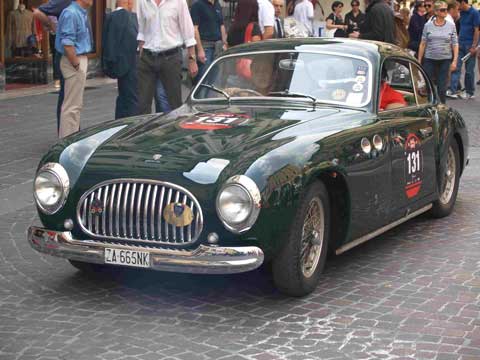
1950 Cisitalia 202 B. Larger than the original, landmark Cisitalia 202 of 1946-47, the later coupes were more powerful but also heavier.
Dusio went to Argentina to begin a new Cisitalia company there, but returned to Italy by 1952, making larger copies of the famous Pininfarina design. It would finally end for Dusio in the mid-1960s.
The Best of the Rest
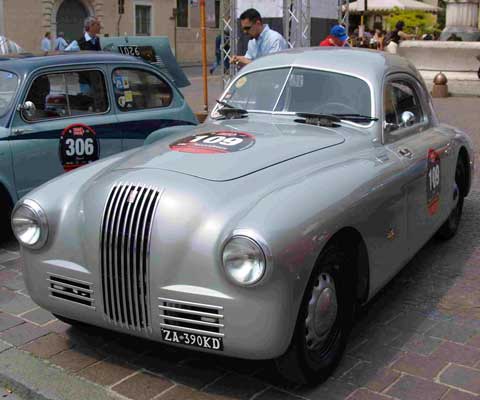
1947 Fiat 1100 S. Fiat did well in the 1947 event with this successor to the 508MM. About 400 of these coupes were built.
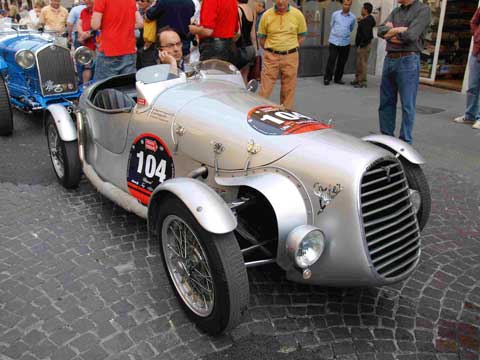
1948 Giannini 750 Sport, one of the more popular etceterinis of the post war races.
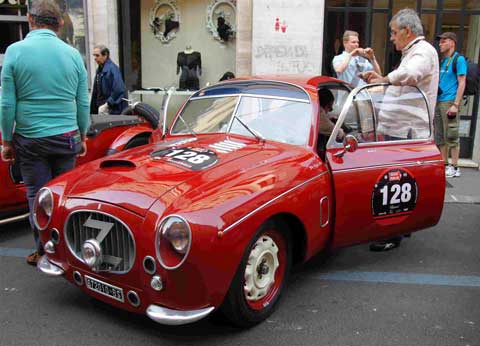
1950 Fiat Zagato 750 MM. Also called the “Panoramica” due to the design of the windows and windshield.
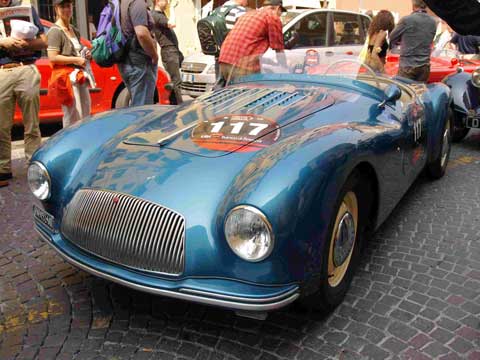
1950 Fiat 1100 Colli body.Colli was founded in 1932 by the four Colli brothers in Milan.
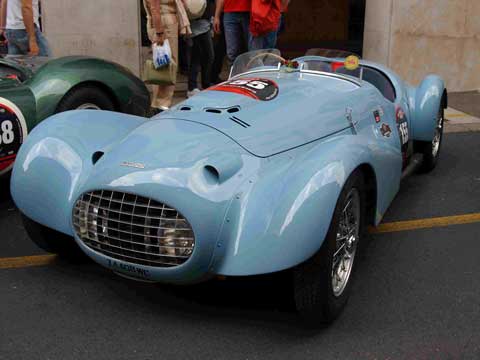
1950 Ermini 1100 Motto body. Motto was Rocco Motto, who established his firm in 1930 and worked on everything from Cadillacs to Delahayes.
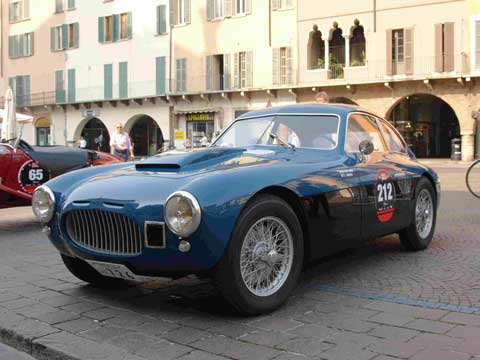
1952 Fiat Otto Vu, this one with a Zagato body.
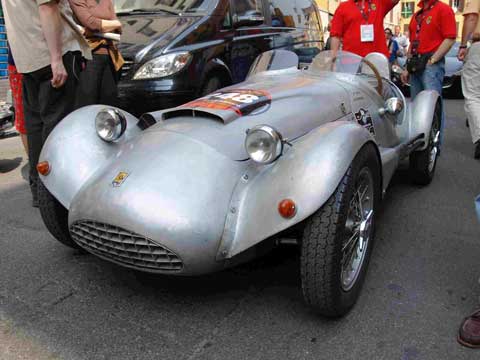
1953 Bandini 750 Sport Siluro. Called “clamshells’ in the U.S., they were very popular in the Mille Migila.
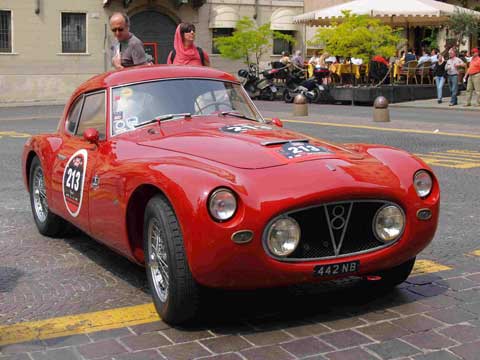
1953 Fiat Otto Vu, a veteran of many post-war Mille Miglias.
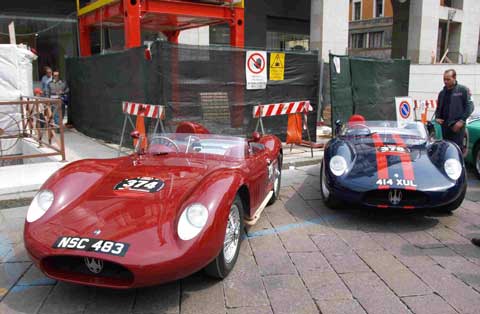
1957 Maseratis, 200SI on left, 250S on right. Ferrari’s nemesis never won the great race, but not for the lack of trying.
What? No post-war Lancia photo? Was there really no Aprilia or Aurelia B20 taking part?
No mention of Bracco’s drive in the 1951 Mille Miglia, on an Aurelia B20 2 liter with 90 bhp? He finished second, 20 minutes behind a 220 hp Ferrari 4.1 liter, driven by Gigi Villoresi. This was certainly instrumental in Gianni Lancia starting the D series racing cars, in 1952. Lancia then won in the 1954 Mille Miglia with the D24. The only post-war MM winners were Alfa, Ferrari, Mercedes, and Lancia!
Sad to see once more that Lancia takes last place in the MM reports, behind Ferraris, Maseratis, Alfas, Oscas, Cisitalias, Fiats and the Etceterinis.
Sebastien is right. Seems a bit peculiar that the etceterini are more featured than the B20. The B20’s success in the 1951 MM may have arguably may have had more impact on the development path of the 1950’s Italian car market than any other post-war result: as it established the idea that a general GT could compete with sports racers.
This image of the GT as all-purpose was hinted at pre-war with the 6C Alfas, but hadn’t taken root post-war. The B20’s success did just that – a rare moment of bridging between production and racing cars. If one follows that line of thought, much of post-war car development can be more clearly understood. Its too bad the article fell into the usual trap of racing cars only….
Amen, Sebastien! Lancia has never been given respect because Lancia made cars that ran 100 mph all day rather than 150 mph cars that would blow up or fall apart.
My mechanic tells me Lancias are for men. The rest are for boys.
Gentlemen,
To be sure, Lancias will be given their due in VeloceToday.
We’d love to publish a long historical article on the fabulous racing Aurelias.
Can anyone help with historical photos?
Pete Vack, Editor
True there is no post-war Lancia photo but it seems to me that Lancia is mentioned FIRST in the article ahead of Maserati, Ferrari, and Alfa:
“The Italians would also dominate the post-war round of Mille Miglia races, but it would no longer be just Alfa Romeo. Lancia would return to serious competition with the 3.3 liter….
I don’t think it’s fair to citicize the great VT for not concentrating on a car that YOU are particularly interested in.
So cheers, Pete and Alessandro, for great coverage of the 2008 MM with pictures I won’t see on any other web site!
-cliff reuter
http://www.etceterini.com
As a Lancia man first and then Abarth, I can well appreciate the comments on the lack of Lancia coverage. However, for people who simply never sees any form of Etceterini, I must commend you for having the pictures of Erminis and the like. Surely we are all well aware of the legendary successes of Lancia and do not need to be reminded with every coverage. I must also say that I really enjoy seeing pictures of Fiats rather than the constant flood of Ferraris. Bring on the pictures of the rare ones that we don’t often see – please.
Adrian Walmsley